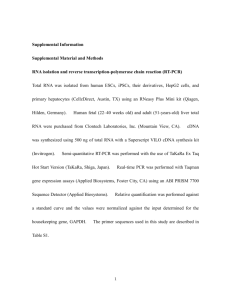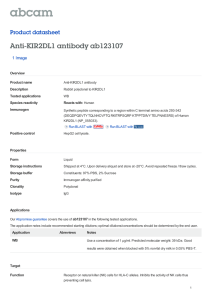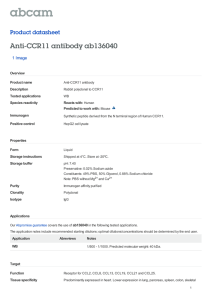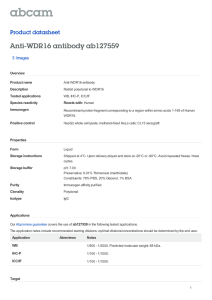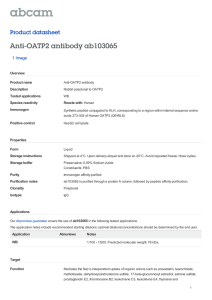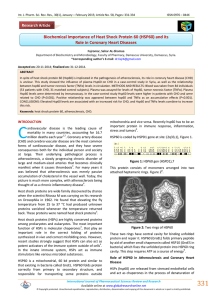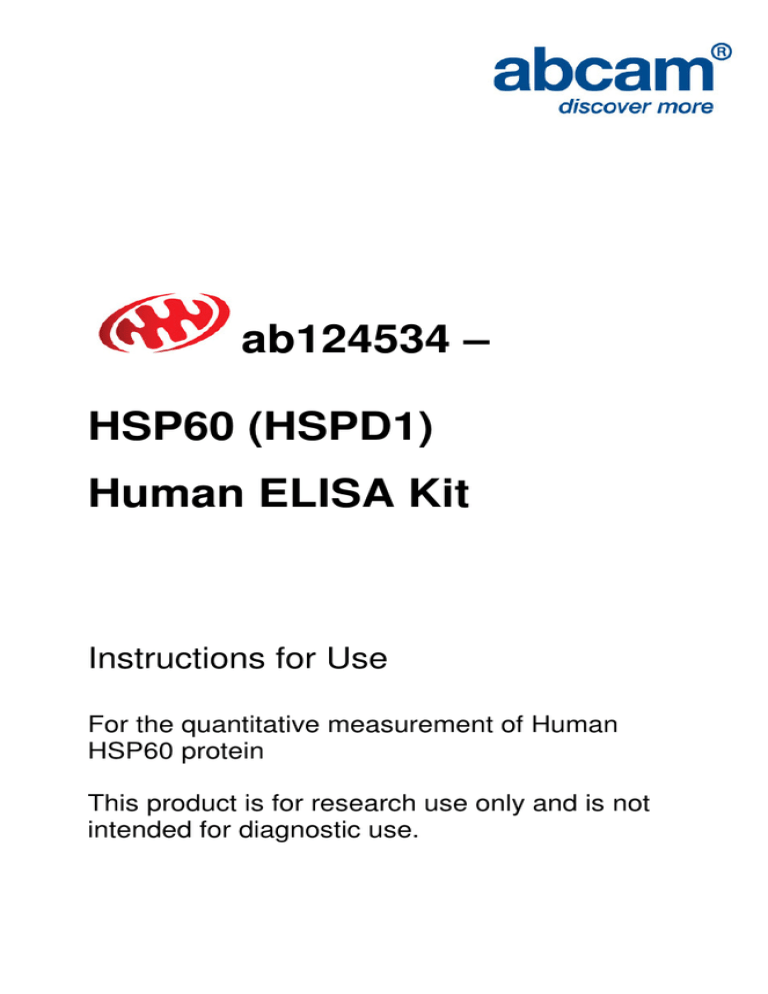
ab124534 –
HSP60 (HSPD1)
Human ELISA Kit
Instructions for Use
For the quantitative measurement of Human
HSP60 protein
This product is for research use only and is not
intended for diagnostic use.
1
Table of Contents
1.
Introduction
3
2.
Assay Summary:
5
3.
Kit Contents
6
4.
Storage and Handling
6
5.
Additional Materials Required
6
6.
Preparation of Reagents
7
7.
Sample Preparation
8
8.
Assay Procedure
11
9.
Data Analysis
13
10. Specificity
17
11. Troubleshooting
19
2
1. Introduction
Principle: ab124534 HSP60 (HSPD1) Human ELISA (EnzymeLinked Immunosorbent Assay) kit is an in vitro enzyme-linked
immunosorbent assay for the quantitative measurement of HSP60
protein a 60 kDa protein encoded by the Human HSPD1 gene, in cell
and tissue lysates. The assay employs an HSP60 specific antibody
coated onto well plate strips. Standards and samples are pipetted
into the wells and analyte present in the sample is bound to the wells
by the immobilized antibody. The wells are washed and an antiHSP60 primary detector antibody is added.
After washing away
unbound primary detector antibody, HRP-conjugated secondary
detector antibody specific for the primary detector antibody is
pipetted to the wells. The wells are again washed, a TMB substrate
solution is added to the wells and color develops in proportion to the
amount of analyte bound. The developing blue color is measured at
600 nm.
Optionally the reaction can be stopped by adding
hydrochloric acid which changes the color from blue to yellow and
the intensity can be measured at 450 nm.
Background: HSP60 (gene HSPD1) is a mitochondrial matrix
protein implicated in protein import from the cytoplasm into the
mitochondrion
and
macromolecular
assembly.
HSP60
is
a
chaperone and so facilitates the correct folding of imported proteins.
HSP60 prevent misfolding and promotes the refolding and proper
assembly
of
unfolded
polypeptides
generated
under
stress
3
conditions in the mitochondrial matrix. HSP60 has been implicated
in diabetes, stress response, certain immunological disorders and
cancer. In several studies of carcinomas decreased HSP60 levels
correlated with poor prognosis.
Specifically defects in HSPD1 are a cause of spastic paraplegia
autosomal dominant type 13 (SPG13). Spastic paraplegia is a
degenerative spinal cord disorder characterized by a slow, gradual,
progressive weakness and spasticity of the lower limbs. Defects in
HSPD1 are the cause of leukodystrophy hypomyelinating type 4
(HLD4); also called mitochondrial HSP60 chaperonopathy or
MitCHAP-60 disease. HLD4 is a severe autosomal recessive
hypomyelinating leukodystrophy. Clinically characterized by infantileonset rotary nystagmus, progressive spastic paraplegia, neurologic
regression, motor impairment, profound mental retardation. Death
usually occurrs within the first two decades of life.
4
2. Assay Summary:
Equilibrate all reagents to room temperature. Prepare all the
reagents, samples, and standards (optional, not included in the kit)
as instructed.
Add 50 µL standard (optional, not included in the kit) or sample to
each well used. Incubate 2 hours at room temperature.
Aspirate and wash each well two times. Add 50 µL prepared 1X
Detector Antibody to each well. Incubate 1 hour at room
temperature.
Aspirate and wash each well two times. Add 50 µL prepared 1X
HRP Label. Incubate 1 hour at room temperature.
Aspirate and wash each well three times. Add 50 µL TMB
Development Solution to each well. Immediately begin
recording the color development for 15 minutes at 600 nm.
Alternatively add a Stop solution at a user-defined time and read
at 450 nm.
5
3. Kit Contents
Item
Quantity
Extraction Buffer
15 mL
20X Buffer
20 mL
10X Blocking Buffer
6 mL
HSP60 Microplate
1
(8 x 12 antibody coated strips)
10X HSP60 Detector Antibody
1 mL
10X HRP Label
1 mL
TMB Development Solution
6 mL
4. Storage and Handling
Store all components at 4°C. This kit is stable for at least 6 months
from receipt. Unused microplate strips should be returned to the
pouch containing the desiccant and resealed.
5. Additional Materials Required
•
Microplate reader capable of measuring absorbance at 600
nm (or 450 nm after addition of Stop solution - not supplied).
6
•
Method for determining protein concentration (BCA assay
recommended).
•
Deionized water
•
Multi and single channel pipettes
•
PBS (1.4 mM KH2PO4, 8 mM Na2HPO4, 140 mM NaCl, 2.7
mM KCl, pH 7.3)
•
Tubes for sample dilution
•
Stop solution (optional) – 1N hydrochloric acid
•
Optional plate shaker for all incubation steps
•
Microplate cover or seals
6. Preparation of Reagents
o
6.1 Equilibrate all reagents to room temperature (18-25 C)
before use.
6.2 Prepare 1X Wash Buffer by adding 20 mL 20X Buffer to 380
mL nanopure water. Mix gently and thoroughly.
6.3 Prepare 1X Incubation Buffer by adding 6 mL 10X Blocking
Solution to 54 mL 1X Wash Buffer. Unused 1X Incubation
Buffer may be stored at -20°C for 6 months after performing
the ELISA.
6.4 Prepare the 1X HSP60 Detector Antibody by diluting the 10X
HSP60 Detector Antibody 10-fold with 1X Incubation Buffer
7
immediately prior to use. Prepare 0.5 mL for each 8 well
strip used.
6.5 Prepare the HRP Label by diluting the stock 10X HRP Label
10-fold with 1X Incubation Buffer immediately before use.
Prepare 0.5 mL for each 8 well strip used.
7. Sample Preparation
Note: Extraction buffer can be supplemented with phosphatase
inhibitors, PMSF and protease inhibitor cocktail prior to use.
Supplements should be used according to manufacturer’s
instructions.
7.1 Preparation of extract from cell pellets
7.1.1
Collect non adherent cells by centrifugation or
scrape to collect adherent cells from the culture
flask. Typical centrifugation conditions for cells are
o
500 x g for 10 min at 4 C.
7.1.2
Rinse cells twice with PBS.
7.1.3
Solubilize cell pellet at 2x10 /mL in Extraction Buffer.
7.1.4
Incubate on ice for 20 minutes. Centrifuge at 16,000
7
x g for 20 minutes at 4°C. Transfer the supernatants
into clean tubes and discard the pellets.
Assay
samples immediately or aliquot and store at -80°C
for 6 months. The sample protein concentration in
the extract may be quantified using a protein assay.
8
7.2 Preparation of extracts from tissue homogenates
7.2.1
Tissue
lysates
are
typically
prepared
by
homogenization of tissue that is first minced and
thoroughly rinsed in PBS to remove blood (dounce
homogenizer recommended).
7.2.2
Suspend the homogenate to 25 mg/mL in PBS.
7.2.3
Solubilize the homogenate by adding four volumes
of Extraction Buffer to a final sample protein
concentration of 5 mg/mL.
7.2.4
Incubate on ice for 20 minutes. Centrifuge at 16,000
x g, for 20 minutes at 4°C.
Transfer the
supernatants into clean tubes and discard the
pellets. Assay samples immediately or aliquot and
store at -80°C. The sample protein concentration in
the extract may be quantified using a protein assay.
9
7.3 Positive control sample dilution series preparation
Note: It is strongly recommended to prepare a dilution
series of a standard control sample (not included in this
kit). The reference standard curves of several human
cell lines can be found in section 8 data analysis.
7.3.1
To prepare serially diluted positive control sample,
label six tubes #2-7.
7.3.2
Prepare a positive control sample lysate or extract
as directed in previous sections (6.1, 6.2). Dilute the
positive control sample to an upper concentration
limit of the working range of the assay in the same
diluent used to dilute other experimental samples.
Label this tube #1.
7.3.3
Add 150 µL of the diluent to each of tubes #2
through #7.
7.3.4
Transfer 150 µL from tube #1 to tube #2.
Mix
thoroughly. With a fresh pipette tip transfer 150 µL
from #2 to #3. Mix thoroughly. Repeat for Tubes #4
through #7. Use the diluent as the zero standard
tube labeled #8. Use fresh control sample dilutions
for each assay.
10
150 µl
150 µl
1
150 µl
150 µl
150 µl
2
3
4
5
1/2
1/4
1/8
1/16
6
150 µl
7
Positive control
sample
1/32
1/64
8. Assay Procedure
Equilibrate all reagents and samples to room temperature
before use.
It is recommended all samples and controls be
assayed in duplicate.
8.1 Prepare all reagents, working dilutions of controls and
samples as directed in the previous sections.
8.2 Remove unused microplate strips from the plate frame,
return them to the foil pouch containing the desiccant pack,
and re-seal.
8.3 Add 50 µL of each sample per well. It is recommended to
include a dilution series of a positive control sample (section
6.3). Also include a no material control (diluent) as a zero
standard.
11
8.4 Cover/seal the plate and incubate for 2 hours at room
temperature.
If available use a plate shaker for all
incubation steps at 300 rpm.
8.5 Aspirate each well and wash, repeat this once more for a
total of two washes. Wash by aspirating or decanting from
wells then dispensing 300 µL 1X Wash Buffer into each well
as described above.
Complete removal of liquid at each
step is essential to good performance. After the last wash,
remove the remaining buffer by aspiration or decanting.
Invert the plate and blot it against clean paper towels to
remove excess liquid.
8.6 Immediately prior to use prepare sufficient (0.5 mL/strip
used) 1X HSP60 Detector Antibody (step 5.4) in 1X
Incubation Buffer. Add 50 µL 1X HSP60 Detector antibody
to each well used. Cover/seal the plate and incubate for 1
hour at room temperature. If available use a plate shaker for
all incubation steps at 300 rpm.
8.7 Repeat the aspirate/wash procedure above.
8.8 Immediately prior to use prepare sufficient (0.5 mL/strip
used) 1X HRP Label in 1X Incubation Buffer (step 5.5). Add
50 µL 1X HRP Label to each well used. Cover/seal the plate
and incubate for 1 hour at room temperature. If available
use a plate shaker for all incubation steps at 300 rpm.
8.9 Repeat the aspirate/wash procedure above, however,
performing a total of three washes.
12
8.10 Add 50 µL TMB Development Solution to each empty well
and immediately record the blue color development with
elapsed time in the microplate reader prepared with the
following settings:
Mode:
Wavelength:
Time:
Interval:
Shaking:
Kinetic
600 nm
up to 15 min.
20 sec. - 1 min.
Shake before and
between readings
Alternative– In place of a kinetic reading, at a user defined,
time record the endpoint OD data at (i) 600 nm or (ii) stop the
reaction by adding 50 µL stop solution (1N HCl) to each well
and record the OD at 450 nm.
8.11 Analyze the data as described below.
9. Data Analysis
Average the duplicate positive controls readings and plot against
their concentrations after subtracting the zero standard reading.
Draw the best smooth curve through these points to construct a
standard curve.
Most plate reader software or graphing software
can plot these values and curve fit.
A four parameter algorithm
(4PL) usually provides the best fit, though other equations can be
examined to see which provides the most accurate (e.g. linear, semi13
log,
log/log,
4
parameter
logistic).
Read
relative
HSP60
concentrations for unknown samples from the standard curve plotted
(for example see Figure 1). Samples producing signals greater than
that of the highest standard should be further diluted in and
reanalyzed, then multiplying the concentration found by the
appropriate dilution factor.
TYPICAL STANDARD CURVE - For demonstration only.
HSP60 ELISA_HepG2 standard curve
∆ mOD/min @ 600nm
1000
100
10
1
0.1
1
10
100
1000
HepG2(ug/ml)
HSP60 ELISA_Hela standard curve
∆ mOD/min @ 600nm
1000
100
10
1
0.1
1
10
100
1000
Hela (µ
µg/ml)
Figure 1. Example standard curves. (Upper) A dilution series of HepG2 cell
lysate in the working range of the assay. (Lower) A dilution series of Hela
cell lysate in the working range of the assay.
14
TYPICAL WORKING RANGES FOR PELLET EXTRACTS
Sample Type
Range
HepG2 cell extract
0.39 - 200 µg/mL
Hela cell extract
3.125 - 200 µg/mL
LINEARITY OF DILUTION
Linearity of dilution determined by comparing dilution series of
extracts prepared from HepG2 cell pellets (starting extract
concentration is 50µg/mL)
HepG2 (µg/ml)
% Expected Value
1:1
71.8
1:2
86.6
1:4
100
1:8
108.5
1:16
118.5
1:32
129.44
1:64
134.94
15
REPRODUCIBILITY
Parameter
CV%
Intra (n=4)
2.1
Inter (n=3)
6.7
RECOVERY
CONTROL
10%
goat
serum
50%
culture
medium
50%
incubation
buffer
25
100
79
99
102
12.5
100
76
97
88
6.25
100
77
95
91
3.125
100
76
95
91
1.56
100
75
93
92
0.78
100
77
93
89
0.39
100
75
87
87
HepG2
(µg/ml)
16
10.
Specificity
Species– Human reactive. Non-reactive with mouse and rat. Others
untested.
The detector antibody in this assay specifically reacts with the 60
kDa HSP60 as shown in Figure 2.
A
B
C
Figure 2. Demonstration the specificity of antibodies used in this kit. (A)
Western blot using the HSP60 detector antibody at 1 µg/mL: HepG2 cell
lysate, HeLa cell lysate, and HDFn lysate, each were loaded at 15 µg/lane.
(B)
Analysis of HSP60 staining in HDFn cells by ICC: HSP60 primary
antibody at 1 µg/mL (green). (C) Analysis of HSP60 staining in Hela cells by
Flow: blue: 1µg/mL HSP60 antibody; red: an equal amount of an isotype
control antibody.
17
HSP60 is expressed at different levels in human cultured cell lines
as indicated by Western blot and determined using this HSP60
ELISA assay shown in Figure 3.
HSP60_HEPG2,HELA, HDFn
comparison of different cell lines
HepG2
HELA
HDFn
100
10
1
0.1
150
∆ mOD/min @ 600nm
100
50
100
1000
material(ug/ml)
HD
Fn
10
H
el
a
1
G
2
0
0.01
He
p
∆ mOD/min @ 600nm
1000
10 µg/well cell lysate
Figure 3. Demonstration of differential HSP60 expression in human cell
lysates. (A)
HSP60 levels are indicated by Western blot in HepG2 cell
lysate (lane 2), HeLa cell lysate (lane 3), and HDFn lysate (lane 4). Each
sample was loaded at 15 µg/lane.
(B) Endogenous HSP60 levels were
detected in different cell lysates using HSP60 ELISA kit. The HSP60 ELISA
kit shows greater sensitive and accuracy to demonstrate the quantitative
relationship among different human cell lines.
18
11.
Troubleshooting
Problem
Poor standard
curve
Low Signal
Large CV
Low sensitivity
Cause
Solution
Inaccurate Pipetting
Check pipets
Improper standard
dilution
Prior to opening, briefly spin
the stock standard tube and
dissolve the powder
thoroughly by gentle mixing
Low HSP60
concentration in sample
Use appropriate positive
control
Incubation times too
brief
Ensure sufficient incubation
times; change to overnight
standard/sample incubation
Inadequate reagent
volumes or improper
dilution
Check pipettes and ensure
correct preparation
Plate is insufficiently
washed
Review manual for proper
wash technique. If using a
plate washer, check all ports
for obstructions
Contaminated wash
buffer
Make fresh wash buffer
Improper storage of the
ELISA kit
Store your reconstituted
standards at -80°C, all other
assay components 4°C.
Keep substrate solution
protected from light
19
20
21
22
UK, EU and ROW
Email: technical@abcam.com
Tel: +44 (0)1223 696000
www.abcam.com
US, Canada and Latin America
Email: us.technical@abcam.com
Tel: 888-77-ABCAM (22226)
www.abcam.com
China and Asia Pacific
Email: hk.technical@abcam.com
Tel: 108008523689 (中國聯通)
www.abcam.cn
Japan
Email: technical@abcam.co.jp
Tel: +81-(0)3-6231-0940
www.abcam.co.jp
Copyright © 2012 Abcam, All Rights Reserved. The Abcam logo is a registered trademark.
23
All information / detail is correct at time of going to print.

![Anti-NFIB / NF1B2 antibody [NFI5I299] ab51352 Product datasheet 2 Abreviews 1 Image](http://s2.studylib.net/store/data/012652889_1-78b7a54670d98a6e5e44b4210d5de4aa-300x300.png)
